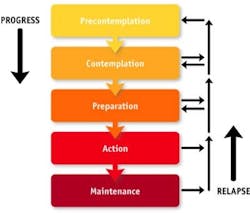by Artemiz Seif Adkins, DDS
Have you noticed the same trend I have? Everywhere I look there are national chain dental practices popping up, often run by business professional as opposed to dental professionals. Perhaps it shouldn’t surprise us. Deep down, we know we’ve been asleep at the wheel for a while now. The last statistic I read was nearly 90% of us enter solo practice within five years of graduation. I’d like to rephrase that: nearly 90% of us enter our caves within five years of graduation. While we go into our solo caves for our 35-hour workweeks, our ever-growing corporate counterparts are negotiating group savings and working on ways to lower our communities’ cost barriers for care. Perhaps we fail to notice that we’re moving toward extinction because we will not be able to compete with the corporate businesses in the long run. The need to adapt and innovateWe are notoriously uneducated in business principles and historically haven’t worked well together. Meanwhile, vendors, insurance companies, and corporate practices are competing all around us full steam ahead. Whether we like it or not, unless we start adapting — and quickly — we can all start saying goodbye to solo practices sooner than later. It’s not enough just to be good doctors anymore. Our profession forces us to combine precise clinical skills with psychology, leadership skills, and business savvy. If we don’t become active participants in all these areas, others will, and our needs will take a back seat to theirs. A couple of years ago, a financial analyst asked a piercing question: “How is it possible that Time Warner owned both Warner Music and AOL and didn’t create something like iTunes?” She mentioned that too many boundaries around a business make for less innovation, and obvious important opportunities will get lost behind such boundaries. Here is our version of this obvious question: How is it that we have been taking care of our patients’ clinical needs for so long, but we haven’t come up with a better financial model for them? Do we really need third parties — i.e. middlemen — to do this for us? And do we really think that while the average per capita income in our nation is under $40,000, we can continue to charge higher and higher fees and still be viable businesses? Business 101 teaches us that the more middle layers there are, the more complicated and costly the model becomes. This may explain why many of us like the fee-for-service model as the desired form of practice. Yet, others believe an insurance-based model is better, and reduced fees will be countered by the increased volume in this model. Seeking other optionsFor the past four years my private solo practice has been a fee-for-service practice. This model fits me well. But I’ve often wondered: Are these the only practice options? There are different business models all around us. For instance, what if, like Costco, we offered a community membership model?Last year, knowing the limitations of the economy, I took a risk and created a community membership model called the Dentist-Patient Alliance program. I signed up 113 “member patients” for an annual fee and gave them certain membership perks, such as reduced costs for services. The model exceeded my expectations. My member patients received four times the services compared to my fee-for-service patients. More importantly, the doctor-patient relationship dynamic with my members was improved when compared to my non-members; 110 of the members completed all of the recommended preventive maintenance and recall protocols I prescribed. In other words, while I turned blue trying to explain why my non-member periodontal patients should see us more often, my member patients called on their own accord and followed recommendations with very little arm-twisting on my part. An important argument can be made here: my health-care outcomes will likely be better than the national average if I can continue to keep my community members engaged in such a way. I will also have less administrative overhead, since there are no middlemen in my practice. My patients and I have no limitations, require no permissions and pre-authorizations, and we have no red tape to work through. Have you ever heard of the “Swarm Theory?” Stanford biologist Deborah Gordon says: “Ants aren’t smart… ant colonies are.” She’s right. Think about penguins; these birds can’t fly, can’t really run, lay no more than one or two eggs each year, and yet have managed to survive the harshest climates on earth for over 40 million years. Coincidence? I don’t think so. Thinking as a collectiveI’d argue that it’s time for us to think as a collective or risk freezing to death. A single penguin would never survive the cold on its own. Instead, penguins live in colonies. During the coldest storms on our planet, they huddle up and continuously rotate their outer friends — who are most exposed to the cold — to the center of the huddle. They keep rotating until the storm is over. Remember Darwin’s lesson: it’s not the strongest of the species that survive, nor the most intelligent, but the one most responsive to change.Dr. Artemiz Seif Adkins is a 2004 graduate of the University of the Pacific. She is a full-time general dentist is in Scottsdale, Ariz.), where she founded the Dentist-Patient Alliance program. She also serves as CEO of Royal Penguin (www.royalpenguin.com), a startup dental supply company. Dr. Artemiz is a member of the Board of Directors of UOP’s Alumni Association, as well as spokesperson for Moms Against Poverty, a California-based nonprofit organization. Visit her practice Web site at www.adkinsdentistry.com.








